Public relations (PR) campaigns are coordinated, strategic efforts designed to shape public perception and influence how the eyes of the public view a brand, organization, or public figures. They serve to:
- Build Brand Visibility and Credibility: By generating media coverage, social media buzz, and word-of-mouth marketing that supports broader marketing strategy and business goals.
- Shape Public Perception: Through storytelling, messaging, and reputation management, a campaign is designed to emphasize positive attributes while mitigating potential negativity.
- Drive Business Growth: Achieved by setting clear PR goals that correlate with increases in sales, attracting investors, and improving stakeholder relationships with the public.
- Handle Crises: Acting quickly and transparently to address negative publicity, often via traditional PR channels like press releases and media relations.
Effective PR campaigns come in many forms, from a digital PR campaign to a corporate branding campaign. They typically blend multiple tactics—such as press releases, social media outreach, and influencer collaborations—to help shape public perception in a consistent manner. A well-devised PR campaign might feature innovative campaign angles, ensuring it stands out among countless marketing campaign initiatives.
What Are PR Campaigns and Their Importance?
Understanding Public Relations Campaigns
A PR campaign is a strategic PR endeavor and a key part of your public relations strategy. The PR campaign definition generally points to a set of planned activities focused on specific objectives—raising awareness, launching new offerings, managing crises, or improving public image.
- Core Components: Creating successful PR campaigns requires setting measurable goals, identifying target audiences, crafting key messages, and selecting relevant PR channels (e.g., media, social media PR, events).
- Strategic Value: Beyond publicity, every PR effort aims to build trust and emotional connections, fostering relationships with the public that lead to long-term loyalty.
- Importance of PR Campaigns: These campaigns can be the catalyst for business growth, brand differentiation, and the success of the campaign in terms of broader marketing or corporate goals.
The Importance of PR Campaigns for Brand Awareness
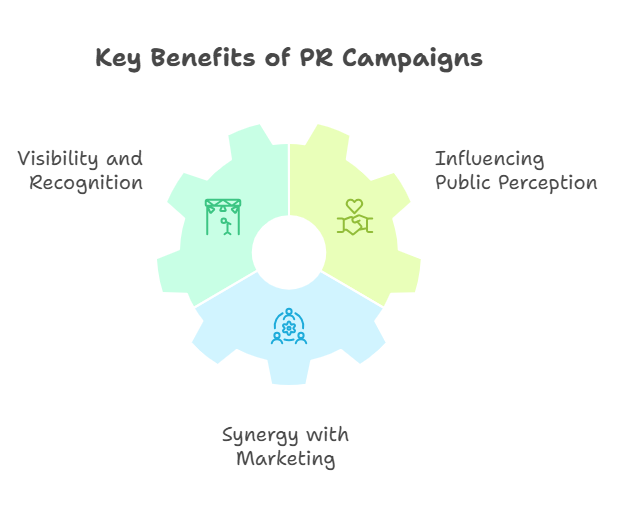
- Visibility and Recognition: The importance of PR campaigns lies in generating consistent, positive mentions across various outlets. This can bring the campaign featured coverage that elevates brand recognition.
- Influencing Public Perception: Aligning campaign aims and messaging with brand values is essential to build consumer trust and loyalty, reinforcing the power of PR to shape public opinion.
- Synergy with Marketing: A campaign is a marketing tool as much as it is a public relations tool. Integrated efforts (e.g., PR and advertising) can maximize exposure and drive comprehensive brand impact.
Examples
- Dove’s “Campaign for Real Beauty”: Often cited among the best PR campaign examples, this campaign launched a fresh narrative on beauty standards, generating extensive media coverage and a meaningful shift in consumer perception.
- KFC’s “Chicken Crisis”: Though not one of the 10 examples of famous PR campaigns typically listed for product launches, it stands out as an example of a successful PR approach to crisis management, turning a product shortage into a humorous apology that protected brand reputation.
How PR Campaigns Contribute to Business Growth
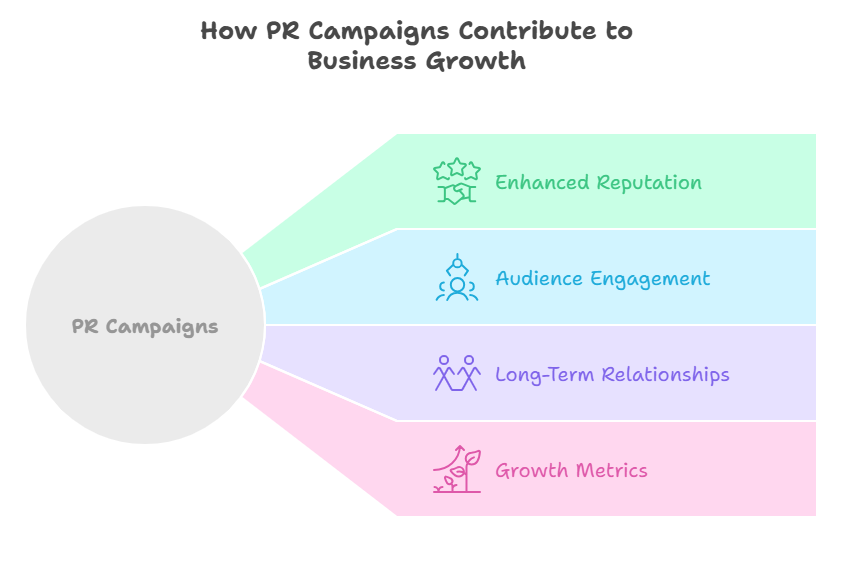
- Enhanced Reputation: Strong coverage fosters trust among potential customers, partners, and investors, ensuring the campaign is doing well for both short-term and long-term brand standing.
- Audience Engagement: Engaging content, often part of social media campaigns, leads to higher interactions and website visits, further supporting business growth.
- Long-Term Relationships: PR professionals understand that building rapport with journalists, influencers, and other stakeholders is crucial to a well-executed PR campaign that continues to bring results.
- Growth Metrics: The success of a PR campaign can be measured in leads, sales, share of voice, stakeholder confidence, and contextual data such as the campaign of the year accolades.
What Makes a PR Campaign Successful?
Key Elements of a Successful PR Campaign
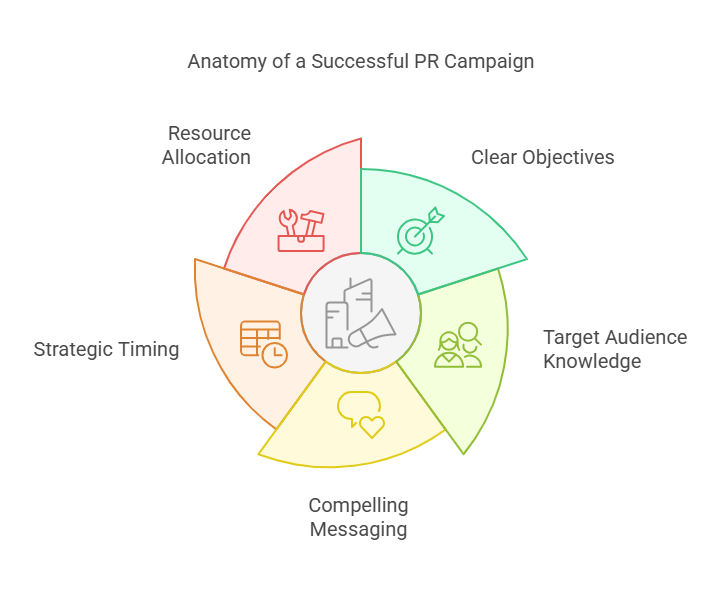
- Clear Objectives: A successful PR campaign requires defining specific, measurable goals (e.g., “Increase website traffic by 25%” or “Secure 10 feature articles in leading outlets”).
- Target Audience Knowledge: Tailor every PR message to the demographic details—interests, behaviors, preferred media.
- Compelling Messaging: Effective public relations hinges on a narrative that resonates emotionally and underscores the brand’s unique value.
- Strategic Timing: Launch the campaign created to coincide with product releases, cultural events, or news trends for maximum impact.
- Resource Allocation: A comprehensive PR campaign depends on sufficient budget, personnel, and tools (e.g., media monitoring software).
Tips for a Successful PR Campaign
- Engaging Content: Attention-grabbing headlines, visuals, or quotes are crucial, especially when embarking on digital PR campaigns.
- Relationship Building: Maintain strong ties with journalists and influencers. Part of your PR strategy involves personalized pitching for better coverage.
- Adaptability: Monitor real-time feedback and adjust if engagement or results aren’t meeting PR goals always set at the campaign’s initiation.
- Consistent Branding: Keep tone and core messages aligned across all platforms, from traditional PR avenues to social media PR.
Measuring the Success of a PR Campaign
- Track Engagement: Use metrics like likes, shares, and comments to assess success of the campaign and whether the campaign was successful in resonating with the audience.
- Monitor Website Traffic: Look for patterns—spikes or sustained increases driven by specific campaign features, perhaps after a campaign featured a series of promotions.
- Evaluate Media Coverage: Measure the quantity of coverage, assess sentiment, and consider if the campaign has also achieved broad impressions among your target audience.
- Sales and Leads: Correlate revenue and new leads generated during the campaign with specific PR tactics to see if the campaign is a marketing success, reinforcing the value of PR strategies.
How to Create a PR Campaign?
Steps to Create a PR Campaign
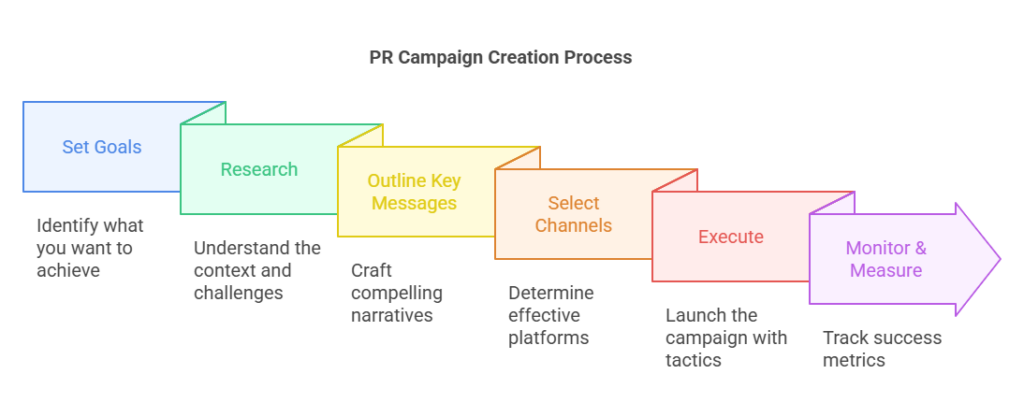
- Set Goals: Identify what you want to achieve—heightened public awareness, brand repositioning, or crisis mitigation.
- Research: Understand the context in which the campaign operates, including industry trends, competitors, and audience challenges.
- Outline Key Messages: Craft concise, compelling narratives aligned with overall business goals, addressing how this campaign might fill audience needs.
- Select Channels: Determine the type of campaign and the platforms where your audience is most active—social networks, trade publications, podcasts.
- Execute: Launch a marketing campaign with tactics such as press release distribution, influencer outreach, and events to ensure a successful PR campaign from start to finish.
- Monitor & Measure: Track coverage, website traffic, and social sentiment to gauge the success of a PR campaign as it unfolds.
- Refine: Use real-time data to pivot, if necessary, ensuring the best PR campaigns of the year remain innovative.
Identifying PR Goals and Target Audience
- PR Goals: Objectives might include increasing brand awareness, improving reputation, driving event attendance, or boosting sales—goals that feed directly into business growth.
- Target Audience: Pinpoint demographics, locations, and behaviors. Creating a successful PR campaign requires messaging and tone that resonate with specific segments.
Crafting the Perfect Press Release for Your Campaign
- Clear Headline: Keep it succinct and aligned with the public relations campaign’s main angle.
- Concise Content: A well-executed PR campaign often leverages short, impactful press releases (about one page).
- Quotes and Stats: Enhance credibility by including leadership insights, alongside relevant data that fosters public image growth.
- Contact Information: Ensure journalists and influencers can easily reach out for more details, making media relations seamless.
What Types of PR Campaigns Exist?
Different Types of PR Campaigns and Their Uses
| Campaign Type | Primary Goal |
|---|---|
| Product Launch | Generate buzz for a new offering; can become campaign of the year if executed creatively. |
| Crisis Management | Protect or restore reputation amidst negative events; an example is KFC’s “Chicken Crisis.” |
| Corporate Social Impact | Showcase philanthropic or social responsibility initiatives, highlighting how PR campaigns can bring goodwill. |
| Event PR | Promote or manage brand events to foster relationships with the public and the media. |
| Influencer PR | Leverage influencer reach and credibility, a hallmark of digital PR campaigns. |
Digital PR Campaign: A Modern Approach
- Online Media Channels: Social networks, blogs, and news sites offer immediate reach and real-time engagement, influencing the success of the campaign.
- Influencer Collaborations: Partnering with social media personalities to extend brand advocacy.
- Search Engine Visibility: Some of the best PR campaigns focus on backlinks and higher organic rankings.
- Real-Time Feedback: Enables quick pivots, ensuring the campaign is doing well in the face of constantly shifting online sentiment.
Media Relations as a Part of Your PR Strategy
- Pitching: Craft unique angles or data points that make the pitch newsworthy.
- Relationship Building: Regularly provide journalists with expert commentary, timely tips, or exclusive stories.
- Newsworthiness: Traditional PR thrives when press releases align with current trends or relevant events.
- Press Kits: A comprehensive PR campaign often includes easy-to-use digital kits with brand assets, executive bios, and key product details.
How to Measure the Success of a PR Campaign?
Key Performance Indicators for PR Campaigns
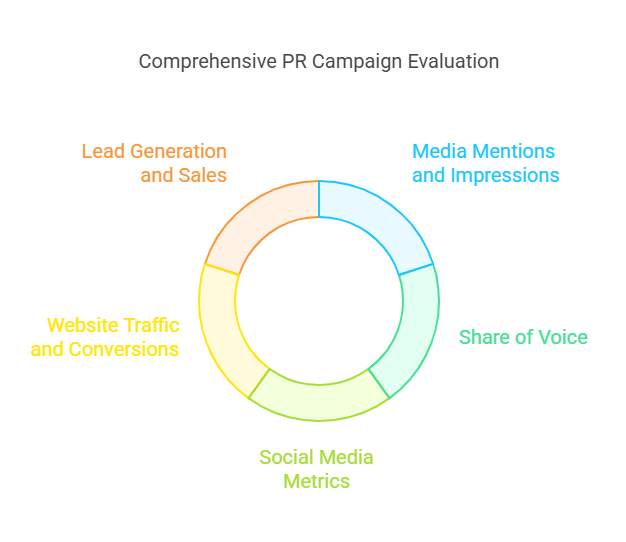
- Media Mentions and Impressions: Quantity, quality, and reach across outlets.
- Share of Voice: Compare mentions against competitors to see which campaign was groundbreaking.
- Social Media Metrics: Follower growth, engagement rates, sentiment analysis—hallmarks of a social media PR approach.
- Website Traffic and Conversions: Identify referral sources, bounce rates, and completed actions (sales, downloads).
- Lead Generation and Sales: Check if the campaign created direct conversions, reinforcing why campaigns and why they worked are a vital study.
Analyzing Media Coverage and Public Perception
- Sentiment Analysis: Determine if coverage is positive, neutral, or negative.
- Message Pull-Through: Evaluate whether outlets and influencers are accurately reflecting the campaign’s key messages and the context in which the campaign is set.
- Influencer Feedback: Influencer endorsements can illustrate how well the campaign featured resonates with target audiences.
- Case Example: When KFC encountered a product shortage, its crisis response showcased how a strategic PR campaign can pivot media sentiment from negative to empathetic.
Post-Campaign Evaluation: What to Look For
- Objective Fulfillment: Determine the success of the campaign by comparing final metrics (mentions, sales, engagement) with initial targets.
- Lessons Learned: Identify which PR campaign work strategies excelled and which fell short.
- Relationship Building: Strengthened bonds with media outlets and new influencer partnerships can spark your next PR campaign.
- Sustainability: Consider if the campaign brought awareness that extends beyond its formal end, offering ongoing brand benefits.
Final Takeaway
A PR campaign is a strategic tool that can help shape public perception, enhance brand credibility, and drive significant business results. Whether it’s an innovative campaign featuring a series of creative executions or one of the campaigns of all time like Dove’s “Real Beauty,” a well-devised PR campaign stands out by having clear objectives, thorough research, compelling messaging, and consistent follow-through.
By integrating both traditional PR and digital PR campaign methods, professionals in PR can create PR campaigns that resonate widely and generate measurable impacts. Through strategic planning, media relations, and consistent monitoring, organizations can harness the power of PR to not only elevate their public image but also achieve meaningful business growth.


